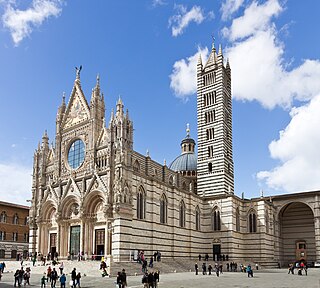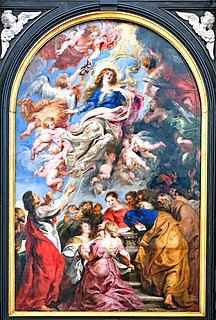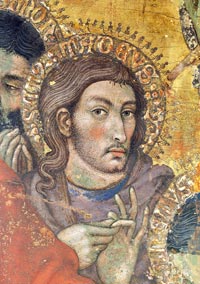
Lorenzo di Pietro, known as Vecchietta, was an Italian Sienese School painter, sculptor, goldsmith, and architect of the Renaissance. He is among the artists profiled in Vasari's Le Vite delle più eccellenti pittori, scultori, ed architettori.

Siena Cathedral is a medieval church in Siena, Italy, dedicated from its earliest days as a Roman Catholic Marian church, and now dedicated to the Assumption of Mary.

The Assumption of the Virgin Mary or Assumption of the Holy Virgin, is a painting by Peter Paul Rubens, completed in 1626 as an altarpiece for the high altar of the Cathedral of Our Lady, Antwerp, where it remains.

Montepulciano is a medieval and Renaissance hill town and comune in the Italian province of Siena in southern Tuscany. It sits high on a 605-metre (1,985 ft) limestone ridge, 13 kilometres (8 mi) east of Pienza, 70 kilometres (43 mi) southeast of Siena, 124 kilometres (77 mi) southeast of Florence, and 186 kilometres (116 mi) north of Rome by car.
Domenico di Bartolo, born in Asciano, Siena, was a Sienese painter who became active during the early Renaissance period. He was inaccurately named by the famous painter, writer and historian Giorgio Vasari as the nephew of well-reputed Italian artist Taddeo di Bartolo, who is featured in Vasari's Lives of the Most Excellent Painters, Sculptors, and Architects. By the early 1400s, Domenico di Bartolo was one of Siena's artists most influenced by the new Florentine style of painting. During the time that he was active and working, Domenico was the only Sienese painter to have received commissions by clients in Florence. Domenico was also employed by Lorenzo Vecchietta, otherwise referred to as Lorenzo di Pietro, to work alongside him for the fresco The Care of the Sick, which is today considered a masterpiece of the Pilgrim's Hall in the hospital Santa Maria della Scala (Siena).

Taddeo di Bartolo, also known as Taddeo Bartoli, was an Italian painter of the Sienese School during the early Renaissance. He is among the artists profiled in Vasari's biographies of artists or Vite. Vasari claims he is the uncle of Domenico di Bartolo.

The Assumption of the Virgin Mary does not appear in the New Testament, but appears in apocryphal literature of the 3rd and 4th centuries, and by 1000 was widely believed in the Western Church, though not made formal Catholic dogma until 1950. It first became a popular subject in Western Christian art in the 12th century, along with other narrative scenes from the Life of the Virgin, and the Coronation of the Virgin. These "Marian" subjects were especially promoted by the Cistercian Order and Saint Bernard of Clairvaux.

The Basilica of San Domenico is one of the major churches in Bologna, Italy. The remains of Saint Dominic, founder of the Order of Preachers (Dominicans), are buried inside the exquisite shrine Arca di San Domenico, made by Nicola Pisano and his workshop, Arnolfo di Cambio and with later additions by Niccolò dell'Arca and the young Michelangelo.

Genoa Cathedral or Metropolitan Cathedral of Saint Lawrence is a Roman Catholic cathedral in the Italian city of Genoa. It is dedicated to Saint Lawrence, and is the seat of the Archbishop of Genoa. The cathedral was consecrated by Pope Gelasius II in 1118 and was built between the twelfth century and the fourteenth century as fundamentally a medieval building, with some later additions. Secondary naves and side covers are of Romanesque style and the main facade is Gothic from the early thirteenth century, while capitals and columns with interior corridors date from the early fourteenth century. The bell tower and dome were built in the sixteenth century.

The Basilica della Santissima Annunziata del Vastato is the Catholic cathedral of Genoa, northern Italy; its decoration employed the major baroque studios and artists in Genoa in the 17th century.

The Coronation of the Virgin or Coronation of Mary is a subject in Christian art, especially popular in Italy in the 13th to 15th centuries, but continuing in popularity until the 18th century and beyond. Christ, sometimes accompanied by God the Father and the Holy Spirit in the form of a dove, places a crown on the head of Mary as Queen of Heaven. In early versions the setting is a Heaven imagined as an earthly court, staffed by saints and angels; in later versions Heaven is more often seen as in the sky, with the figures seated on clouds. The subject is also notable as one where the whole Christian Trinity is often shown together, sometimes in unusual ways. Crowned Virgins are also seen in Eastern Orthodox Christian icons, specifically in the Russian Orthodox church after the 18th century. Mary is sometimes shown, in both Eastern and Western Christian art, being crowned by one or two angels, but this is considered a different subject.

The Church of Santa Maria dei Servi is a Romanesque style, Roman Catholic church in the Terzo of San Martino in the city of Siena, Tuscany, Italy.

The Sanctuary of Gibilmanna is a Christian shrine in the province of Palermo, Sicily, southern Italy. It is located in Gibilmanna, a frazione of the comune of Cefalù on a slope of the Pizzo Sant'Angelo, a peak in the Madonie chain, at an altitude of some 800 m.

The Pontifical Shrine of the Blessed Virgin of the Rosary of Pompei is a Roman Catholic cathedral, Marian pontifical shrine and minor basilica commissioned by Bartolo Longo, located in Pompei, Italy. It is the see of the Territorial Prelature of Pompei.

Andrea di Bartolo or Andrea di Bartolo Cini was an Italian painter, stained glass designer and illuminator of the Sienese School mainly known for his religious subjects. He was active between 1389–1428 in the area in and around Siena.

The Diocesan Museum in Cortona is an art museum in Cortona, Tuscany, Italy. Located on the former site of the local Church of Gesù, it houses works of art by artists such as Fra Angelico, Pietro Lorenzetti, Bartolomeo della Gatta, Luca Signorelli and Sassetta. The oldest item in the museum is a marble Roman sarcophagus, depicting depicts the battle of Dionysus.

The Girdle of Thomas, Virgin's Girdle, Holy Belt, or Sacra Cintola in modern Italian, is a Christian relic in the form of a "girdle" or knotted textile cord used as a belt, that according to a medieval legend was dropped by the Virgin Mary from the sky to Saint Thomas the Apostle at or around the time of the Assumption of Mary to heaven. The supposed original girdle is a relic belonging to Prato Cathedral in Tuscany, Italy and its veneration has been regarded as especially helpful for pregnant women. The story was frequently depicted in the art of Florence and the whole of Tuscany, and the keeping and display of the relic at Prato generated commissions for several important artists of the early Italian Renaissance. The Prato relic has outlasted several rivals in Catholic hands, and is the Catholic equivalent of the various relics held by the Cincture of the Theotokos of Eastern Orthodox Church and Holy Girdle of Syriac Orthodox Church.

Avellino Cathedral is a Roman Catholic cathedral dedicated to the Assumption of the Virgin Mary and Saint Modestinus in Avellino, Campania, Italy. It is the seat of the bishops of Avellino.
The Oratory of the Compagnia di Santa Caterina della Notte is a highly decorated prayer hall present in the top floor of the medieval Hospital of Santa Maria della Scala in Siena, region of Tuscany, Italy.

San Francesco is a Romanesque- and Gothic-style Roman Catholic church located in the center of Lucignano, region of Tuscany, Italy.

















